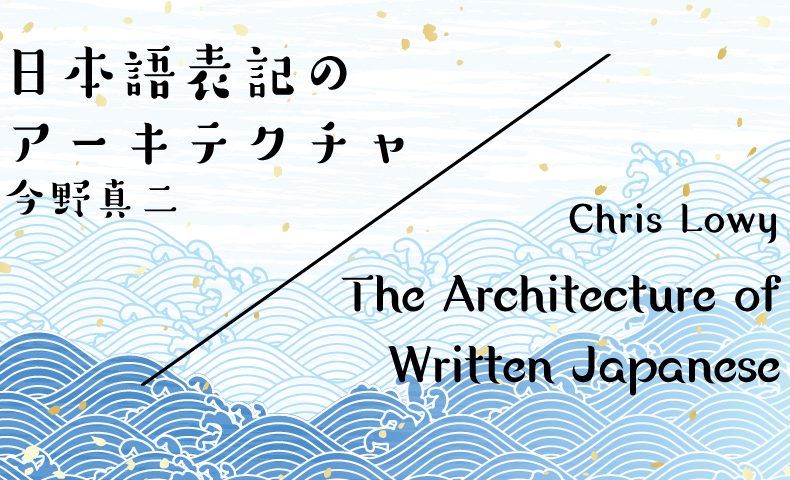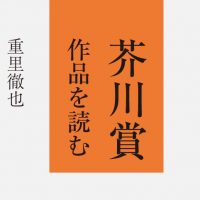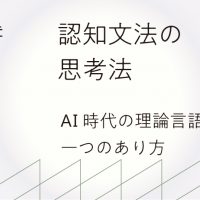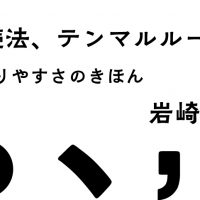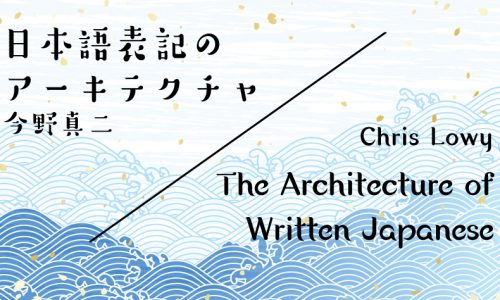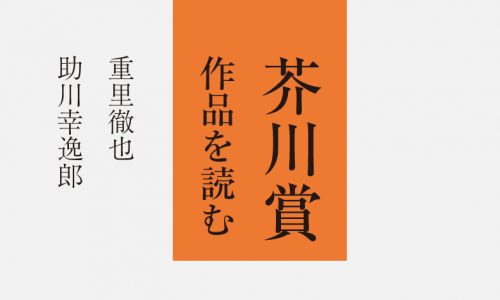今野真二
[書記・表記・アーキテクチャ]
このたび、ひつじ書房のご好意により、「日本語表記のアーキテクチャ」というタイトルのもと、今野とChristopher Lowy氏によって、12回にわたって原稿を連載することになった。
今野は日本語によって原稿を書き、Christopher Lowy氏は英語によって原稿を書き、二つの原稿を併載する。日本語の原稿と英語の原稿との関係はさまざまで、英語の原稿が日本語の原稿の翻訳もしくはそれにちかいものである場合もあれば、やや「距離」がある場合もあり、また、両者が同じテーマについての独立した原稿である場合もある。また一つの原稿が、日本語と英語とが交互に配置されるかたちで提示される場合もある。日本語の原稿のみ、英語の原稿のみをお読みいただいてもいいし、双方をお読みいただいてもいいという試みである。
「正書法(orthography)」のない日本語表記についての分析、考察は、「正書法」のある言語圏、例えば英語圏において必ずしもよく知られているわけではなく、そうしたこともこのような掲載形式を試みる理由の一つとなっている。
第1回では、連載で使う用語とその概念について説明しておきたい。
「書記」「表記」という用語、概念についてまず採りあげることにする。両者のいずれかしか使わない研究者もいるが、ひとまず両者について整理しておくことにする。
尾山慎(2021)は「書記論は、何かが書かれるときに、そこにおいて実現するあらゆる現れを考究対象とする。すなわち字の形、濃淡、かすれ、配置、連綿があればその切れ続き、大きさ等である。一人一人、あるいは一人の中でも一回一回異なるものとしてその用例を認め、考究するのが書記論である。検討事項があまりに多岐にわたる上、産出には必ずどこかにカオス的要素が関わっているので、行為そのものを考察にいれるのは時に難しい」(16p)と述べ、「書記論とは理論上あらゆることが検討対象になりうる」(17p)と述べる。しかしその一方で、「真の意味での書記論を隈無く実行する手立ては、現時点では我々にはないと思う。よって、ある程度抽象された論を書記論と措定すべきところである」(16p)と述べている。
尾山慎(2021)は「個別事象と抽象化した一般化」(16p)という表現もしており、言語を「個別事象」側でとらえるのが「書記」といってよいだろう。尾山慎(2021)は「検討事項があまりにも多岐にわたる」と述べているが、そもそも「検討事項」がどれほどあるかがわかっていないともいえ、結局は観察者、論者の目的、必要に応じて、想定される「検討事項」を絞ることになる。「絞る」とは整理であり、整理とは抽象化といってよい。したがって、言語の「個別事象」側に「書記」という概念を設定したとしても、何らかの抽象化はされていることになる。
連載第2回ではChristopher Lowy氏の考える、日本語の「書記」にかかわる8つの「検討事項」を提示し、以下の回ではその「検討事項」について述べていくことにしたい。
引用でわかるように、尾山慎(2021)は「書く」という表現を使っている。「カク」(註1)は、「筆で文字をカク」「藤原定家が明月記をカク」のように多義であるので、前者の場合は「文字化」という用語を使い、できるかぎり「書く」という表現を使わないようにこころがけることにする。
また、「文字化」は「言語情報を文字によって視覚化する」ことを指す。同じように考えると「言語情報に音声によってかたちを与える」プロセスは「音声化」ということになる。
「書記」という概念を改めて定義するならば、「文字化に際してあらわれてくるすべての事象」ということになる。
尾山慎(2021)は実現している文字にかかわる「要素をできる限り排除して抽象化したもの」(17p)が「表記」であると述べている。尾山慎(2021)は、上代に関して、木簡や古文書、金石文のような、当該時期に文字化された「実物」がなければ、当該時期についての「書記論」は成り立たないと述べているが、例としてわかりやすい。
「表記」という概念は「言語の文字化をある程度抽象化してとらえたもの」ということになる。「抽象化」は「表記システム」の検討といってもよい。
設定をあまり大きくしないのであれば、ある時期の、ある「文字社会」(文字を扱う集団)ごとに共有されている「表記システム」がある、という「みかた」が稿者の仮説的な「みかた」である。この「表記システム」に基づいて、実際の文字化が行なわれる。つまり「書記」の背後には「表記システム」があるというのが稿者の「みかた」といってよい。
尾山慎(2021)が述べるように、「表記」というとらえかたと「書記」というとらえかたは、「連続的」(18p)で「相互包括」的になり、上位、下位の関係あるいは二項対立的な関係にはならない。「書記」を抽象化して「表記」に至るのだから両者が「連続的」であることはいうまでもないが、具体的な「書記」をまったく離れた「表記」分析は考えにくいし、「表記」的な観点をまったく離れて「書記」を観察することも難しい。そうした意味合いにおいて「書記」と「表記」とは「相互包括」的、相即的な関係にある。
この連載では、「書記」的観点にたった観察、分析を行なう。むしろそうした観察、分析を積極的に採りあげ話題にする。しかしそれは、「表記(システム)」を視野に入れながらということである。
現象の観察を超えて、あるいは現象の観察からさらにふみこんで、その「観察」を言語観察という枠組みの中に、あるいは言語観察をさらに超えた枠組みの中に、定位させ位置づけるという営みは重要であると考える。第11回「文学テキストにおける文字表現」はそうしたことの試みの一つといってよい。
言語学という枠組みの中で行なわれる営みは、まずはその枠組みの中に収まっている必要がある。しかし、その営みの成果が、言語学に隣接する学、あるいは隣接しない学にとっても興味深いものであることは喜ばしいことであって、忌避するようなことではない。そのように意識していたからといって、そのようになるとは限らないし、意識していなくてもそうなることはありそうで、意識するかしないかは「結果」にはかかわらないともいえよう。そうであっても、論じていることがらがどのような枠組みの中にまず置かれるか、その周囲にはどのような枠組みがあるのかに目配りをすることには一定の意義があると考える。言語活動がヒトという生物にとって重要な営みである以上、そうした目配りが大事であることはいうまでもない。
したがって、この連載においては「書記」的観点にたった観察、分析を行なっていくが、それを含めて「日本語表記」と名づけていることをここでことわっておきたい。「書記的表記論」といってもよいかもしれない。
『三省堂国語辞典』第8版(2022年)は見出し「アーキテクチャ(ー)」を「製品の設計思想。特に、コンピューターのハードウェアやソフトウェアの基本構成」と説明している。この説明をあてはめるならば、連載の総題「日本語表記のアーキテクチャ」は日本語の表記がどのような基本構成をしているかを論じることになる。そしてすでに述べたように、それを「書記」的観点にたった観察、分析に基づいて行なう。
[書き手・読み手・観察者]
「書き手」「読み手」「観察者」ということについても述べておきたい。
稿者は、「書き手」側にたったモデルをまず設定している。「書き手」の脳内に他者に伝えたい何らかの「情報」がある。この「情報」は言語以外の手段によっても伝えることができる。怒った顔の絵文字やスタンプを友人に送ることで、その友人に自身が不快を感じているということを伝えることはできるだろう。「どん引き」されるかもしれないけれども、怒った顔の絵を友人にわたすこともできる。これらは非言語による伝達ということになる。しかし「いったんは怒ったけれども今はそうでもない」「今は怒っているけれども、おそらく明日になったら、この気持ちはおさまると思うよ」というような複雑な「情報」になれば、言語による伝達をするしかない。
かたちをもたない「情報」に言語によってかたちを与えるプロセスを「言語化」と呼ぶことにする。言語化された「情報」を音声によって「音声化」して「音声言語」としてアウトプットすることもできるし、文字によって「文字化」して「文字言語」としてアウトプットすることもできる。アウトプットされて初めて、言語によって「情報」に与えられたかたちがすがたをあらわす。これは「話し手」「書き手」を起点としたモデルということになる。
この連載では、「日本語表記」をめぐっての話題が軸となるので、「話し手」についてはひとまず措き、「書き手」に話題を絞ることにする。
「書き手」がどのようにして「情報」を文字化して「文字言語」としてアウトプットするかということがまずあって、「読み手」はそのアウトプットされた「文字言語」を「書き手」の「言語情報」に「還元」しようとする。「書き手」の「言語情報」に過不足なく「還元」できれば、「読み手」は「書き手」がアウトプットした「文字言語」を正確に読み解いたことになる。しかし、いつも100パーセント過不足なく読み解くことができるとはかぎらない。読み解けない「情報」が残ることも少なくないであろう。あるいは「書き手」が意図していない「情報」を「読み手」がよみとることもあろう。これはいうなれば「誤読」あるいは「深読み」ということになる。
しかし、アウトプットされた「文字言語」に接していて、自身の過去の経験を懐かしく想起したとすると、それは「誤読」であろうか。「読み手」が「あらぬ妄想」に耽ることは「書き手」には想定されていないかもしれないが、そうしたことを「よむ」ということとどのように結びつければいいのだろうか。
「書き手」がアウトプットした「文字言語」が、文学作品のようにあるまとまりをもったテキストを形成している場合、そのテキストには、比喩的に表現するならば「書き手」「読み手」双方の「声」が響いていることになる。テキストはそのように、「多声的(polyphonic)」な存在であるともいえよう。
「書き手」がアウトプットしたものが、具体的な物のように、手渡しできたり、写真に撮ることができるような物ではない以上、文字化された「情報」を「よむ」とはどのようなことか、という大きな問いがありそうに思われる(註2)。
文学テキストに「書き手」と「読み手」双方の「声」が響いていると感じるのは、「読み手」もしくは、テキストから少しあるいは遠く離れて観察している「観察者」ということになる。『源氏物語』のテキストを使って論文を書こうとしている研究者はこの「観察者」の位置にある。「観察者」は「書き手」が文字化したテキストを観察することで「書き手」について考えることができ、当該テキストをよんださまざまな時期の「読み手」がどのように読んだかを推測することによって、「読み手」について考えることができる。そして、そうした行為を通して、自身が何を考えたかを内省することができる。
「書記」と「表記」が相互干渉的であるように、「書き手」と「読み手」も相互干渉的であり、また「書き手」「読み手」に「観察者」を加えた三者も相互干渉的な関係にならざるを得ない。「客観的な観察」「客観的な分析」はそもそも成り立たないという「みかた」はあるだろう。「客観的な観察・分析」といった場合の「客観的」は「観察者」を消すということでもある。観察をして分析をしている「観察者」が存在しているから、論文が存在しているにもかかわらず、あたかも論文の「書き手=観察者」は存在しないかのように論文を書く。「観察者」の存在を消すことによって、覆われてきたことがらは少なくないのではないだろうか。そうしたことについてもこの連載では可能な限り考えてみたい。
[かきことば]
稿者は『書かれたことば』において、「かきことば」と「書かれたことば」とを区別した。「かきことば」は、文字言語を盛る「器」としてかたちづくられているものを指す。一方、「書かれたことば」は文字化された言語そのものを指す。同様に、「はなしことば」は、「かきことば」ほどではないにしても、音声言語を盛る「器」としてかたちづくられているものを指す。
例えば、木簡には文字化された言語情報が記されており、それは必ず「書かれたことば」とみることができるが、だからといって、それが「かきことば」であるとは限らない。あるいは、「はなしことば」をできるだけそのまま文字言語に移し換えたものは、「書かれたことば」ではあるが、「かきことば」ではないことになる。
稿者は、「はなしことば」と「かきことば」とは「回路」で結ばれていると考えている。それが稿者のモデルといってもよい。「かきことば」と「はなしことば」とが「回路」で結ばれているのであれば、「かきことば」に「はなしことば」が投影されることもあり、「はなしことば」に「かきことば」が投影されることもあり、「かきことば」「はなしことば」も相互干渉的で、その意味合いにおいても「多声的(polyphonic)」であることになる。このことについては第12回「はなしことばとかきことばとの距離」において詳しく述べる予定であり、またこうした「みかた」は第11回「文学テキストにおける文字表現」にも深く関わる。
文字言語を盛る「器」としてかたちづくられた「かきことば」は、そこに文字言語を盛りつけて具体的な存在として提示される。そこには「書き手」が積極的に、すなわち意識的に伝えたかった「情報」が盛りこまれるとともに、「書き手」も意識していない「情報」が盛りこまれることもある。「読み手」は提示された「かきことば」を「読み手」のリテラシーや、自身が蓄積している個人的な言語経験にてらしあわせながら「よむ」。そして、観察者、研究者はいわば「書き手」「読み手」ごと「かきことば」を観察し、分析する。
仮に「かきことば」を中性的(neutral)な存在とするならば、その「中性的なかきことば」の周囲に「書き手」「読み手」「観察者・研究者」が存在することになる。「かきことば」と「はなしことば」とが「回路」で結ばれているのならば、「はなしことば」も「かきことば」の周囲に存在していることになる。
そのようにとらえた「中性的かつ多声的な存在としてのかきことば」を「テキスト」と呼ぶこともできそうであるし、電車を乗り降りする多くの人々が立つ「プラットフォーム」と呼ぶこともできそうに思われる。「プラットフォーム」にはいろいろな人の声が響いているという意味合いで「多声的」な場所とみることができる。どこかへでかけていく人も、どこかから帰ってきた人も「プラットフォーム」に立つ。そういう意味では「プラットフォーム」は起点でもあり終点でもある「よりどころ」といってもよい。
この連載は「かきことば」をこうした意味合いでの「プラットフォーム」ととらえることによって、「書記」を含んだ日本語表記について、できるかぎり多面的にとらえていくことを目的としている。
註1 「カク」のようにかたかなで文字化し、鉤括弧に入れたものは、具体的な文字化を経ていない、語そのものをあらわす。「カク」という語が漢字と平仮名で文字化されたものが「書く」ということになる。この表示方式では、「カク」という語そのものと片仮名によって文字化された「カク」とが区別できないが、ひとまずこの表示方式に依ることにする。
註2 金田一春彦(1988)は新聞のスポーツ欄に「捕邪飛」とあることを採りあげて、「果たしてどう読むのだろうか。ホジャヒ?キャッチャーファウルフライ?わからない。ただし、意味はよくわかる」(16p)と述べ、「漢字は読み方がわからなくてもいいということがあるらしい」(同前)と述べている。この「みかた」は亀井孝(1957)「古事記はよめるか―散文の部分における字訓およびいはゆる訓読の問題-」の「みかた」と通う。すなわち、漢字によって日本語を文字化した場合、文字化されている語(句)が具体的な語句すなわち発音形と結びつかない、結びつかなくてもよい、という文字化があったのではないかという「みかた」である。これを特殊な文字化とみることはもちろんできるだろうし、語は特定できないけれども、「情報の伝達」は行なわれているという意味合いで、「情報の伝達」という観点を設定してもよいであろう。そしてさらにいえば「情報」とは何かということにもつながっていく。
参考文献
尾山慎 2021『上代日本語表記論の構想』(花鳥社)
亀井孝 1957「古事記はよめるか―散文の部分における字訓およびいはゆる訓読の問題-」(平凡社『古事記大成』言語文字篇所収。後、1985年、吉川弘文館「亀井孝論文集4」再収)
金田一春彦 1988『日本語』(新版上下)(岩波新書)
今野真二 2010 日本語学講座第1巻『書かれたことば』(清文堂出版)
Chris Lowy
Introduction
Over the next year, Professor Konno Shinji (今野真二)[1] and I will be serializing a collection of essays examining the Japanese writing system. We have this platform thanks to the generosity and support of Hituzi Syobo Publishing Company (ひつじ書房), an academic publisher specializing in various aspects of Japanese linguistics and literature. The format of our serialization is somewhat novel: over 12 installments we will both present articles on a set topic, with Konno writing in Japanese and myself writing in English. Sometimes my contribution will echo what Konno writes and other times our stances will differ from each other. On certain occasions my contribution will be an annotated translation of Konno’s work, and on others our contributions will be completely independent from each other. Nevertheless, one goal is shared between us, namely, to present thoughts on the Japanese writing system from a variety of perspectives and to encourage consideration of the role the Japanese writing systems plays in the creation of literary spaces. No essay will contain an expectation of a bilingual reader: one can read only the Japanese or English contributions and follow along without issue. And, of course, since the content of the Japanese and English essays differ from each other we expect bilingual readers to enjoy both.
As will become clear throughout this serialization, my interest in the Japanese writing system stems largely from its use by authors in Japanese-language literature. Authors writing in Japanese can, and often do, utilize written language as an expressive tool in diverse and complex ways. Indeed, some critics are surprised to learn that literature in Japanese can be written in a style that subverts the hegemony of so-called modern standard Japanese, gives voice to various marginalized communities, or is simply used to reflect narrative developments in a way that tethers narrative content to the written form. Unfortunately, there has been little work in Japanese or English examining the use of written language in literature and, as such, there is little established – let alone shared – vocabulary. Thus, another goal of this serialization is to provide the reader with the language necessary to think about the way written language shapes the act of reading.
There is no one better to embark on this journey with than linguist Konno Shinji. Beginning with his 2001 A Study of Kana Orthography (仮名表記論攷)[2], Konno has published countless articles and more than 60 books – both academic texts and those with a general reader in mind – on the topic of the Japanese writing system. Significantly, and of great interest to me, he does not describe the historical development of the writing system as if it were an uninhabited island evolving in an environment removed from the influence of the surrounding world. Rather, his work embraces the complexity of extra-lingual elements that come together to shape both the way the writing system developed (develops) and how it is deployed in a variety of settings, not the least of which is literature. Indeed, to borrow Konno’s own terms, his approach is at the same time “microscopic” (虫瞰) and “macroscopic” (鳥瞰).[3] Furthermore, Konno’s interest in literature and linguistics, especially the point of intersection between spoken language, written language, and literary expression makes his contributions relevant to scholars of Japanese-language literature. For example, his recent publication on the use of language (the “style”) by famed mystery writer Edogawa Rampo proposes a re-reading of Rampo based not on the heavily edited (but easily accessible) Complete Works of Edogawa Rampo but, instead, calls for a return to the original publications and a consideration of what Rampo’s language – both diction and written form – can tell us about the author, his editors, and the stories he tells.[4] In this way, Konno’s approach to analyzing script usage in literature puts him into dialogue with critics working in the larger field of textual studies.
In the remainder of this first installment, I define some keywords necessary for discussing written language. Because the concept of writing is nearly universal key terms are slippery: if a scholar uses a given term one way, ten others use it another way. Additionally, one scholar might deviate from a precise usage of a keyword (e.g., “writing”) and slip into its “common sense” usage. My goal is to remain as precise as possible, but I apologize in advance for the slippages that are guaranteed to occur. The second installment sketches the parameters of what I call the architecture of written Japanese, with installments 3-8 describing each element in detail. Installments 9-12 considers how an analysis of written language can inform our reading of literary texts. During these final installments I also demonstrate how downplaying the expressive potential of written language has resulted in large lacunae in our reading of modern and contemporary literature and propose a reexamination of literature from the perspective of written language.
Writing, Orthography, Architecture of Written Language
Before we can talk about the Japanese writing system it is necessary to clarify what we mean when we say writing. This is, unfortunately, a cursed task, as any definition of writing is likely to yield failure for one of two reasons: either it is too broad and thus of little use in analyzing a particular writing system or it is too narrow and thus neglects the great diversity of writing systems. Peter Daniels and William Bright, for example, succinctly define writing as “a system of more or less permanent marks used to represent an utterance in such a way that it can be recovered more or less exactly without the intervention of the utterer” (Daniels and Bright 1996). This definition, from their influential The World’s Writing Systems, understands the act of writing as secondary to speaking, hence the emphasis on “utterance” and “recover[y].” So, while this definition is generally true, and covers the functional aspects of writing broadly conceived, it leaves little room for a writing practice tied to, for example, literary expression. That is, the highly visual poetry of ee cummings or Yoshimasu Gōzō challenges the assumptions about writing situated at the core of Daniels and Peter’s definition. It seems likely that their script practice would be dismissed as “ludic,” a convenient way of overlooking literary usages of written language that prioritize the act of writing over the act of recording utterances. In other words, Daniels and Peter understand the act of writing as one beholden to speech, a hierarchical understanding of the relationship between speech and written language made famous by, perhaps most notably, linguist Leonard Bloomfield and his school of thought.
On the other end of the spectrum is Wolfgang Behr’s ambitious definition:
Writing is an artificial (man-made), conventionalized, typically two-dimensional notation system of visual communication, through which a linguistic proposition may be represented in such a way that any speaker of the natural language in which the proposition has been made and who has learned the structural rules of representation [of] the notation system, is capable of retrieving [the] oral speech act more or less unambiguously, irrespective of the pragmatic situation in which the retrieval takes place, and without recourse to additional performative or acoustic additional information.
(Handel 2019)
Though Behr is careful in his language he, too, prioritizes the spoken word over the written. Both Peters and Daniel and Behr are linguists, so it is only natural that their definitions reflect an interest in the spoken word. When thinking about writing and its relationship to written language, however, a definition that includes writing for literary expression must be considered. My focus, then, is on the text as it exists before a reader. As I have stated elsewhere, I understand writing to
be a mode of representing language rooted in the spoken word but existing independently of it. Writing always exists within the structural limits of the script it appears in […]. Writing can refer to both handwritten texts and printed material, digital forms of language and, at its most extreme, representations of language that do not belong to any typically recognized script system. That is, writing is understood to be broad enough to encompass representations of language that appear in manuscripts and scribbled notes; books and magazines and advertisements; messages on Twitter and Facebook; and, in some cases, even emoji.
(Lowy 2021)
For me, then, when I say writing (or written language) I am referring to the text that sits before a reader and the tools afforded an author writing in a particular script that enables them to produce the texts they produce. That is, here I am less interested in how a text represents spoken language or why a script developed the way it did.[5] For the sake of clarity, I refer to this settled text – the result of “writing” – as an inscription. Though often referring to words inscribed on a monument, I use the term because it suggests finality. Simply put, an inscription “refers to the text a reader encounters when they engage with a piece of literature,” some form of a completed text that a reader engages with (Lowy 2021). I use the term to stress the fact that the act of writing is a dynamic process while the act of reading a literary text – a text born of “writing” – requires stability. Put another way, the difference between a draft and a final text (of which there might be many!) is the difference between the process of writing and the resulting inscription. An inscription, of course, can come in any form, for example as a printed text or in digital form.
Another term one must contend with is orthography. Literally “correct” (ὀρθός) and “writing” (γραφία), the term broadly refers to the spelling conventions of a given language within a particular writing system.[6] English, for example, has a conservative orthography: among other things, spelling is relatively fixed and thus stable.[7] From this perspective, Konno’s claim that Japanese lacks a true orthography – that is, a fixed spelling system – is well-warranted.[8] His claim is not a bombastic one: as I will discuss in a future installment, the rules of written Japanese allow those writing in the script great variability in how they represent language. Indeed, this lack of a true orthography is reflected in the most frequently encountered translation of orthography into Japanese, hyōki (表記 lit. “open-faced writing”). A notoriously difficult term to render into English, hyōki refers to the particular manner (among many options) in which language is represented in a literary text (an inscription). Hyōki is juxtaposed with seishohō (正書法 lit. “correct/proper writing rules”), the term commonly used as a semantic equivalent to the English “orthography.” I must stress here that this does not mean written Japanese has no rules. Rather, it means that written Japanese offers more flexibility to people writing in the Japanese script than, say, English. This is because the architecture of written Japanese – the structure of the language and what is permissible – is different from that of written English. In summation, then, when Konno says Japanese lacks an orthography, he means it lacks a conservative orthography like English and not that it lacks rules, conventions, or standard ways of writing. It is precisely here, in the border between an orthography and a non-orthography, that the power for expression and experimentation lies. This power for expression, in turn, is readied by the architecture of the written language. In the next installment I will explain what I mean by an architecture of script and present the eight components of the architecture of written Japanese, specifically.
Works Cited
- Daniels, Peter T. & Bright, William. The World’s Writing Systems, Oxford University Press 1996.
- Handel, Zev. Sinography: The Borrowing and Adaptation of the Chinese Script, Brill 2019.
- Lowy, Christopher. “At the Intersection of Script and Literature: Writing as Aesthetic in Modern and Contemporary Japanese-language Literature,” University of Washington, PhD Dissertation 2021.
- Lowy, Christopher. “Japanese Literature at the Intersection of Text and Narrative Content,” in Nande Nihon kenkyū suru no / Why Study Japan?, eds. Sachi Schmidt-Hori and Wendy Matsumura, forthcoming 2023.
[1] Note that proper names will follow the conventional Japanese order, namely, family names are followed by first names. I have provided Chinese characters for proper names and terms as I see fit.
[2] 今野真二 2001『仮名表記論攷』(清文堂出版)
[3]今野真二 2005『文献から読み解く日本語の歴史』(笠間書院)
[4] 今野真二 2020『乱歩の日本語』(春陽堂書店)
[5] For an important academic study on why the Chinese script developed the way it did in China, Korea, Japan, and Vietnam, see Zev Handel’s Sinography: The Borrowing and Adaptation of the Chinese Script. For entertaining (but equally serious) commentary on various East Asian writing systems, see Handel’s Twitter account @ZevHandel.
[6] If I seem to be careful with my language it is intentional. For example, one can write the Chinese language in the Chinese writing system or the Latin alphabet. Writing in Chinese characters does not require one to indicate tones; writing in Pinyin, however, does.
[7] I must note that this does not mean that spelling in English is easy. On the contrary, its rigid orthography resists spelling reforms that would otherwise more accurately reflect pronunciation.
[8] 今野真二 2013『正書法のない日本語』(岩波書店)

